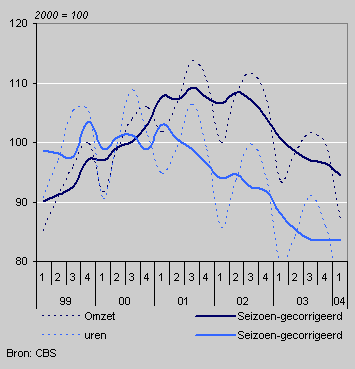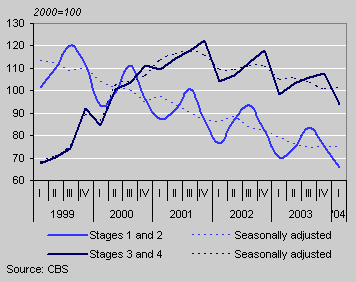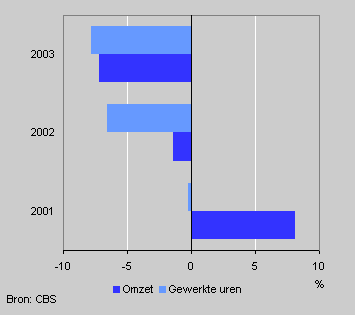Low point for turnover of temp agencies

Although the temporary employment agency branch has suffered a loss of hours for its temporary employees since 2001, this did not result in an immediate loss of turnover. Legislation introduced in 1999 resulted in many temporary employees moving into better paid jobs where they generated more turnover. However, since the third quarter in 2002 turnover too has been falling. In the first quarter of 2004 turnover in this sector reached its lowest level for four years.
Temp agencies: turnover and hours, per quarter

Another sharp fall in turnover
In periods of economic recession the demand for labour dwindles and unemployment increases. These are unfavourable developments for the temp sector. Since the third quarter of 2002, that is now seven quarters in a row, this sector has realised a lower turnover. The most recent figures from Statistics Netherlands show that turnover in the first quarter of this year was 6 percent lower than in the first quarter of 2003.
Temp agencies: turnover and hours, per stage

Above average wage rises
Although the legislation mentioned above does not prescribe wage levels, it is very likely that the promotion to a subsequent stage is accompanied by an increase in salary. The collectively agreed wage levels for the employment agency sector in the first quarter of 2004 were 20 percent above the level of 2000. The average wage rise for all sectors of industry was substantially lower (12 percent) in the same period.
Turnover and hours

Fewer hours, and only later less turnover
Because of the above average wage rise in the temp sector, the loss in hours did not immediately lead to a lower turnover. While the total number of hours dropped in 2001, it took another year before the turnover started to fall. In 2001 when hours fell by 0.2 percent, turnover still increased by 8 percent. The first fall in turnover was observed in 2002: 1 percent, while the number of hours worked fell by 7 percent.
In 2003 the decreases converged somewhat: turnover fell by 8 percent and hours by nearly 9 percent. The positive impact that experienced temporary employees had on turnover had passed in 2003. The stages system has now been revised.
Roos Schellings